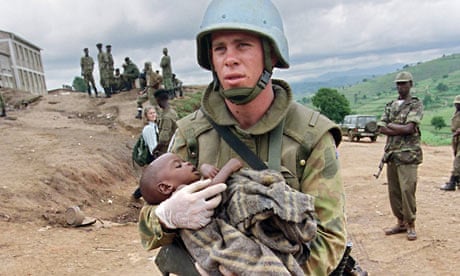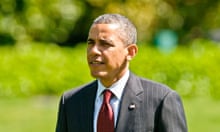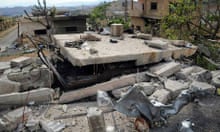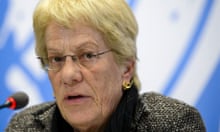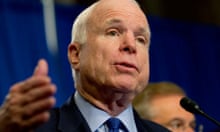The Russian foreign minister Sergei Lavrov, in a recent interview, produced a piece of paper from his pocket with a quote from Alexander Gorchakov, a 19th-century Russian prince who served as the tsar's foreign minister.
"Foreign intervention into domestic matters," intoned Lavrov to Susan Glasser, Foreign Policy's editor-in-chief, "is unacceptable. It is unacceptable to use force in international relations, especially by the countries who consider themselves leaders of civilisation."
As ministers in the US, UK and France push for greater intervention to prevent Syria's bloodshed, Lavrov's remark stands not only as a rebuke to the ambitions of those who would do more to stop Bashar al-Assad, but to an entire doctrine of humanitarian intervention – Responsibility to Protect (R2P) – whose future is uncertain.
Drawn up by the UN in response to the wars of the 1990s, not least in Bosnia and Rwanda, which both saw atrocities that would be defined as genocidal, R2P was adopted by the UN as a "norm" for dealing with conflicts where civilians were under attack in 2005.
Its language has been referred to – or invoked directly – to justify the French interventions in Ivory Coast in 2011, in Mali earlier this year, and the Nato-led no-fly zone imposed over Libya during the conflict that led to the fall of the Gaddafi regime. But now, facing precisely the kind of terrible conflict the doctrine was designed to mitigate or largely prevent, the brave new UN model for protecting civilian victims of war has stalled.
As both the US and the UK's defence secretaries indicated last week that they are examining different military options, a debate has erupted over the future of military interventions on humanitarian grounds, and their claimed necessity.
Those arguments have ranged from the moral to the utilitarian and the self-interested – witness the argument that by not acting the US, in particular, damages its future "credibility" when it threatens the use of force. They have been made amid a rethinking of how these military interventions are actually conducted, from the large-scale operations and expensive, flawed, nation-building efforts that were seen in Iraq and Afghanistan to "lighter footprint" interventions seen recently in Libya, Mali and Ivory Coast.
Opponents of different kinds of intervention in Syria have cited complex practical problems, including how to arm a rebel side numbering a significant minority of jihadist fighters. But one of the biggest stumbling blocks has been how R2P itself has been applied in the recent past – not least in Libya.
Gareth Evans, Australia's former foreign minister, is also an international lawyer jointly responsible for drafting the document taken on by the UN in 2005. He is among those who admit that a doctrine designed to give meaning to the promises of "never again" made after the Holocaust and the killing fields of Cambodia, Bosnia and Rwanda has met difficulties. "What punctured the optimism that the world might be on its way to ending internal mass atrocity crimes once and for all," said Evans, "is the controversy that erupted in the security council in 2011 about the way the norm was applied in the Nato-led intervention in Libya, and the paralysis that in turn generated in the council's response to Syria." Last year Evans spoke of a collapse of international consensus that had led to "paralysis" over Syria.
"I believe that – like most midlife crises – this one will prove survivable … but I can't pretend that its full realisation will not be a work in progress for a long time to come."
The deliberations over Libya, Evans argues, marked the "high water mark" of R2P – seeing the new norm referred to in two UN security council resolutions authorising "all necessary means" in the conflict. But the subsequent "backlash" is still being felt today.
"The concern was about what came after when it became rapidly apparent [to Brazil, Russia, India, China and South Africa] that the three permanent council-member states driving the intervention [the US, UK and France, or "P3"] would settle for nothing less than regime change, and do whatever it took to achieve that.
"Particular concerns were that the interveners rejected ceasefire offers that may have been serious, struck fleeing personnel that posed no immediate risk to civilians and locations that had no obvious military significance [like the compound in which Gaddafi relatives were killed] and, more generally, supported the rebel side in what rapidly became a civil war, ignoring the very explicit arms embargo in the process."
For Russia, Libya provided confirmation of its objections to R2P in the first place. For other countries such as South Africa, which had backed the principle of a new norm for intervention to prevent atrocities, the use of R2P for regime change in Libya – and the refusal of the P3 to report on the progress of the operation and its new parameters – were seen as betrayal.
Jennifer Walsh, professor of international relations at Oxford University who has studied the development of R2P, agrees with Evans's analysis. But she also identifies a "moral hazard" inherent in R2P – that it can create a perception in conflicts that a rebel force may be only a regime-sponsored atrocity away from international interveners coming to its aid. The incentive for rebels to find a negotiated solution is thus reduced.
As Walsh points out, the suspicion that recent interventions have been too easily dominated by the agenda of the US, Britain and France has led to a push-back, led by Brazil.
The Brazilians and others are seeking to insist that any future military interventions on humanitarian grounds authorised by the UN should be guided both by a "prudential" assessment of the practicality of achieving the desired outcome in complex conflicts and informed by a mechanism for transparent, real-time reporting of the progress of operations to council members, to prevent resolutions being used as blank cheques by the P3 countries.
This leaves the question of what the international community could do if it were proved definitively that chemical weapons had been used by the Assad regime in Syria, evidence that the British and US governments were backing away from last week.
Some US officials in private have suggested that at best any change in policy would see the provision of small arms to the "right rebels" in groups not tainted by association with jihadist elements, an even lighter footprint than the intervention in Libya. Others, including senators – such as John McCain, and analysts, have been calling for full-blown intervention. Options that have been mooted range from air strikes, to no-fly zones, the creation of safe havens and humanitarian corridors, and even a Bosnian-style soft partition of the country.
The Lib Dem peer, Paddy Ashdown, who was a soldier in Northern Ireland and then high representative in Bosnia after the war there, disagrees that Libya set a damaging precedent, but adds it would be "folly" to intervene in Syria or lift the EU arms embargo.
"R2P was in some respects a way of legitimising the intervention in Kosovo. I thought it would remain an aspiration but the effect of Libya was to turn from being a collection of words into being a precedent. It remains, however a principle subject to the will of the powerful to enforce it."
Ashdown believes, too, that the more limited intervention in Libya – despite the country's post-Gaddafi unrest and political instability – remains a far better model than the occupation of Iraq, leaving Libyans in charge of their own destiny.
"It was not perfect but it was far less of a mess than Iraq."
Nonetheless, he argues forcefully that, even with the existence of R2P, a key test for intervention is whether it is both practically applicable or whether it will do more harm than good.
"One of the key lessons of interventions is the unintended consequences that follow," he adds. Ashdown warns: "There has been a tendency to see Syria in simplistic black and white – powerless civilians against a brutal dictator – without trying to understand the wider regional tension involved."
Echoing Ashdown last week was Daniel C Kurtzer, a former US ambassador to Egypt and to Israel, writing in the New York Times.
"Before making a momentous decision on intervention – especially if the president is considering unilateral intervention – we ought to first do serious diplomacy to see whether an international consensus can be reached on the question of intervention …
"Indeed, the Syria crisis presents an opportunity to turn away from unilateralism and to adopt instead a more strategic, multilateral approach to resolving international crises."
